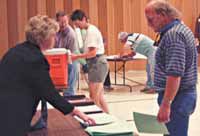| One of the numerous public meetings UDOT held on the helper interchange. |
The often controversial, long awaited and increasingly expensive Helper Interchange that the Utah Department of Transportation wants to build in Carbon County has hit yet another roadblock, and it’s in the same ballpark as the last setback.
The problem? The lowest bid on the latest rendition of the plan was six million dollars more than UDOT has to spend.
“We are befuddled by this situation,” said Myron Lee, spokes man for UDOT’s region four operations. “In our estimation it has to do with the economy and the increased price of materials.”
In October 2003 when the first round of bids were let, engineers estimated that the cost of the project would be around $13 million. However the lowest bid that came in during that process was for over $20 million.
UDOT went back to the drawing board, did some things to stream line the project and found enough money to bring the pot they had to spend almost up to the lowest bid that was submitted late last year. When they let out the bid earlier this year they were confident that they would find a contractor who would want the work for the money they had.
But when the estimates from contractors came in this time, the lowest bid on the project was $26 million. That was about $6 million more than the lowest bid that was submitted last time and about that same amount more than UDOT has to spend.
“Over the past few months since we took the last bids the economy has driven prices up,” explained Lee. “Steel has gone up 40 percent and obviously the oil prices have driven everything else up, particularly asphalt.”
Lee also explained that the contractors that are capable of doing such a large job have plenty of work right now. It is well known in the construction industry that when there is a lot of work for bidders, the prices go up. Contractors can be more picky about which jobs they want to do.
“The fact is that we are not going to be able to award the project for construction to begin this summer,” stated Lee unequivocally.
In fact UDOT’s state office doesn’t even have the individual bids listed on it’s web site. In it’s place is a letter from Thomas LeHolm, UDOT’s manager of contracts explaining that the contract will not be awarded because the lowest bid was over 10 percent above the engineers estimate.
“What we are going to do is to stand back and look at the project again and try to see what we can do to bring the costs more in line with what we have to spend,” stated Lee. “This means we have to go back to the drawing board and maybe even close to square one before it can move ahead again.”
The project which has been in the works for several years, and has had a multitude of public hearings to discuss the pros and cons of the issue may well now have to be revamped so much that the community and UDOT have to come together a few more times before things are settled.
In November of 2003, after the project was pulled back for high bids the first time, Lee was asked if the cost of the project would keep it from happening. At the time he said it wouldn’t. That was probably because UDOT officials thought they could change some specifications to bring the cost down and they expected the bids to come in at about the same rate. No one expected an increase of millions of dollars.
But Lee says not to count the project among the deceased yet. It will almost be mandatory that the project be built in one manner or another if the highway is to be expanded to four lanes between Spanish Fork and Green River. UDOT has already purchased the right-of-ways for the project and has spent a large amount of money on studies and engineering.
Opposition to building the interchange has emerged the last couple of years, but it has been largely unorganized, with various individual citizens speaking out against the project. Many of them feel the overpass will actually divide the community even more that it already is. Others are concerned that the cost is too high. This latest news will probably make them even more adamant about the amount of money it will take. Some feel that traffic lights could accomplish the safety purposes the overpass is designed to address. Still others feel the project will take business away from Helper merchants.
“What can we do?” asked Lee. “We will just go on, reevaluate and look to build this project at a future date. What becomes even more important now will be Helper’s participation in whatever new approach we come up with.”

